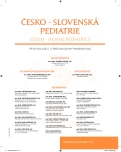-
Medical journals
- Career
Food preferences in 15 years old children – an ELSPAC study
Authors: J. Fiala 1,3; L. Kukla 2
Authors‘ workplace: Ústav preventivního lékařství, Lékařská fakulta Masarykovy univerzity, Brnovedoucí prof. MUDr. Z. Derflerová Brázdová, DrSc. 1; Recetox, Přírodovědecká fakulta Masarykovy univerzity, Brnovedoucí prof. RNDr. I. Holoubek, CSc. 2; Mezinárodní centrum klinického výzkumu, FN U sv. Anny, Brnovedoucí doc. MUDr. T. Kára, Ph. D. 3
Published in: Čes-slov Pediat 2013; 68 (3): 139-148.
Category: Original Papers
Overview
Taste and food preferences belong to factors influencing the nutrition of children, its composition and energy intake. Genetically determined taste preferences are responsible for the fact that food preferences rather do not correspond to principles of healthy nutrition. Food preferences mature in the period of adolescence and the changes concern even selection of food. The study investigated food preferences in a large group of adolescents and included the observation to what extent there preferences are projected into a real food selection.
The research was performed in 1655 adolescents at the age of 15 years within the framework of an ELSPAC study in the area of Brno city. The preferences and frequencies of consumption were followed in 56 items altogether in 8 food and one drink groups using guided interviews.
The preferences were not too well connected with healthy nutrition, showing disagreement in 60% of the most favored items. In contrast, many recommendable kinds of food were quite low in the second half of the preference scale. The reported real consumption, however, reflected quite another picture and corresponds much better to healthy nutrition. This comparison is described in detail by analysis within the framework of individual food groups, some of which are rather homogeneous, whereas in other groups there are greater differences between suitable and less suitable alternatives. Cereals are not favored, but most consumed, whereas fruit is favored and also often consumed. The highest non-homogeneity was on the meat group or protein sources, where items belong to little favored except poultry. On the other hand the consumption of smoked meats is higher than the liking would suggest.
Our results revealed in particular that in contrast to general assumptions the preferences and projected into the real selection of food weakly and do not represent a decisive factor. It appears to allow full play for intended favorable influence in children nutrition.Key words:
nutrition, children, adolescents, food preferences, food, drinks, food groups, foodstuff, selection determinants, ELSPAC
Sources
1. Benton D. Role of parents in the determination of the food preferences of children and the development of obesity. Int J Obes Relat Metab Disord 2004; 28 (7): 858–869.
2. Breen F, Plomin R, Wardle J. Heritability of food preferences in young children. Physiology & Behavior 2006; 88 (4–5): 443–447.
3. Wardle J, Cooke L. Genetic and environmental determinants of children‘s food preferences. Br J Nutr 2008; 99 (Suppl 1): S15–21.
4. Harris G. Development of taste and food preferences in children. Curr Opin Clin Nutr Metab Care 2008; 11 (3): 315–319.
5. TonNu Ch, MacLeod P, Barthelemy J. Effects of age and gender on adolescents‘ food habits and preferences. Food Quality and Preference 1996; 7 (3–4): 251–262.
6. Cooke LJ, Wardle J. Age and gender differences in children‘s food preferences. Br J Nutr 2005; 93 (5): 741–746.
7. Noble C, Comey M, Eves A, Kipps M, Lumbers M. Food choice and secondary school meals: the nutritional implications of choices based on preferences rather than perceived healthiness. International Journal of Hospitality Management 2003; 22 (2): 197–215.
8. Russell CG, Worsley A. Do children‘s food preferences align with dietary recommendations? Public Health Nutr 2007; 10 (11): 1223–1233.
9. Tláskal P, Hrstková H, Schwartz J, et al. Výživové zvyklosti českých školních dětí – 1. část: Výběr potravin a vitaminy. Výživa a potraviny 2012; 67 (3): 58–60.
10. Guidetti M, Cavazza N. Structure of the relationship between parents‘ and children‘s food preferences and avoidances: an explorative study. Appetite 2008; 50 (1): 83–90.
Labels
Neonatology Paediatrics General practitioner for children and adolescents
Article was published inCzech-Slovak Pediatrics

2013 Issue 3-
All articles in this issue
- Food preferences in 15 years old children – an ELSPAC study
-
Incidence of idiopathic enteric inflammations in children and adolescents in the Plzeň (Pilsen) Region in 2001–2011.
A Prospective study - Nutritional screening upon admission to hospital – NutriAction
- Congenital surfactant deficiency due to ABCA3 mutations leading to fatal respiratory failure in a newborn
- Hirschsprung´s disease and its genetic cause
- Czech-Slovak Pediatrics
- Journal archive
- Current issue
- Online only
- About the journal
Most read in this issue- Hirschsprung´s disease and its genetic cause
- Nutritional screening upon admission to hospital – NutriAction
- Congenital surfactant deficiency due to ABCA3 mutations leading to fatal respiratory failure in a newborn
-
Incidence of idiopathic enteric inflammations in children and adolescents in the Plzeň (Pilsen) Region in 2001–2011.
A Prospective study
Login#ADS_BOTTOM_SCRIPTS#Forgotten passwordEnter the email address that you registered with. We will send you instructions on how to set a new password.
- Career

